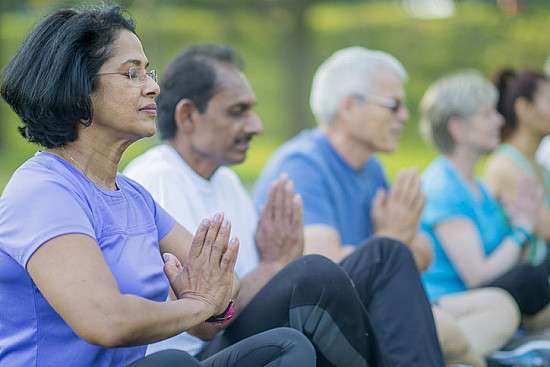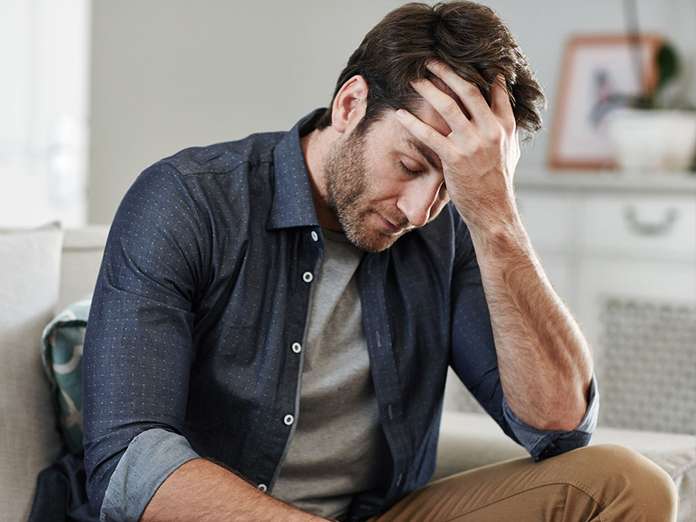Yoga as an intervention in psychiatric disorders is not a recent concept, as doctors have been recommending yoga-based interventions for stress-related disorders since a long time. However, there has been a renaissance in the last two decades, in terms of a scientific approach and modern research methods to the study of yoga-based interventions.
Yoga practice is known to improve a person’s physical and mental functioning. In psychiatry, yoga-based interventions have been successfully used both as a standalone and a supportive treatment of disorders such as depression, anxiety, and insomnia. Yoga has also been beneficial as a complementary treatment for psychiatric conditions such as schizophrenia, Attention Deficit Hyperactivity Disorder (ADHD) in children, and cognitive impairment in the elderly.
Yoga practice has led to improved cognitive performance in persons with depression, better emotion recognition abilities in persons with schizophrenia, and improved memory, sleep and quality of life in elderly persons with mild memory impairment.
Regular practice of yoga causes a reduction in the ‘stress hormone’ cortisol, increase in the ‘cuddle hormone’ oxytocin and increase in markers of brain plasticity such as Brain Derived Neurotrophic Factor (BDNF). It helps prevent degeneration of brain cells, or even an increase of brain volume in areas related to memory (hippocampus), especially in the elderly A neuro-imaging study on healthy persons showed that chanting ‘Om’ reduced brain activation in areas related to emotional control, suggesting that it has the potential to calm emotional disturbances.
Should you happen to have visited a major city in the past 10 or 20 years, you might have noticed a health trend: yoga. The thousands-year-old Indian spiritual practice made its way into gyms, universities and even religious centres worldwide. New yoga centres seem to pop up weekly, advertising new yoga styles and making new health claims. Interestingly enough, yoga is not just perceived as a recreational activity but mainly as a way to increase and maintain health: national surveys show that about 31 million U.S. adults (more than 13% of the population) have used yoga for health reasons.
Yoga has been shown in clinical trials to improve pain by stretching muscles and aligning posture, to lower blood pressure by rebalancing the autonomous nervous system and to reduce inflammation by regulating chronic stress. In recent times, yoga is more and more perceived not only as a way to reduce stress and increase physical fitness but also to overcome mental suffering. This should not really come as a surprise: already about 2000 years ago the Indian sage Patanjali, the “grandfather” of modern yoga, defined yoga as the “control of the fluctuations of the mind”. And “fluctuations of the mind”, rumination or uncontrollable thoughts are cardinal symptoms of several mental disorders.
This potential of yoga to control unwanted mind wandering has hit the big time when Hillary Clinton reported how “alternate nostril breathing”, a classical yogic breathing technique, helped her to heal from her election loss – and from giving up her lifelong dream of becoming president of the USA. However, beyond gossip and anecdotal evidence, there are hard scientific facts and clear mechanisms by which yoga might help with mental symptoms:
Trauma-related symptoms
Post-traumatic stress disorder (PTSD) is a major public health problem affecting up to 6% of the world population. PTSD results from substantial traumatic experiences and is thus far more common among veterans, survivors of wars or natural disasters, and victims of violence. The syndrome is characterized by re-experiencing, avoidance and arousal. PTSD is associated with a brain structure called the amygdala which connects the memory of certain experiences with emotions – in the case of PTSD the amygdala is overactivated and thereby constantly produces the aforementioned symptoms.
By reducing stress, yoga can increase parasympathic activity, this is the relaxation response, and could thereby directly reduce amygdala activity. This seems to be mainly driven by yogic breathing such as alternate nostril breathing. From a psychological viewpoint, PTSD is characterized by the paradox that patients feel anxious about the future although the traumatic event lies in the past. This is mainly driven by an overgeneralization of past experiences and negative appraisal of own actions, negative reactions by other people and life prospects.
Yoga involves aspects of mindfulness, this is a non-judgmental open attention to and acknowledgment of even unpleasant emotions or memories. This can increase emotion regulation rather than avoidance. The mindful awareness of the transitory nature of one’s momentary physical, sensory, and emotional experience during yoga practice is thought to lead to a change in self-appraisal, thereby reducing PTSD symptoms.
In line with these thoughts and theories, clinical trials have shown that yoga actually can reduce symptoms of PTSD: studies from North and South America and Australia have recruited veterans and other people with traumatic experiences and randomly allocated them to yoga interventions lasting weeks to months or to control groups which were not treated at all or received rather unspecific health counseling. In a meta-analysis of these studies, my colleagues and I demonstrate that those participants who practiced yoga experienced a much stronger and clinically relevant reduction in their symptoms – even if the yoga style was not specifically designed for participants with PTSD.
Fear and anxiety
Other studies have targeted anxiety disorders. Anxiety is a normal response to specific situations or events. Without anxiety, mankind would surely not have survived. However, excessive fear or anxiety may be indicative of an anxiety disorder. In generalized anxiety disorder (GAD) for example, elevated levels of anxiety, which are associated with concerns about health, relationships, work, and financial issues, lead to a wide variety of physical symptoms and behavioral changes. In the U.S., more than 4% of the population have been estimated to suffer from GAD alone.
Excessive anxiety also has implications for long-term health, with somatic symptoms of anxiety, such as palpitations and irregular heartbeat, being associated with an increased risk of cardiovascular disease. Interestingly, treating anxiety is one of the main reasons people give for practicing yoga. Again, mindfulness seems to play a key role here: patients with GAD have been shown to be less “mindful” than the general population, indicating that mindful body work, breathing and meditation can help here – perhaps by “controlling the fluctuations of the mind”? Interestingly, anxiety disorders are more prevalent among patients with breathing disorders such as asthma or chronic obstructive pulmonary disease and breathing retraining has been an essential part of many cognitive behavior therapy approaches for anxiety disorders.
Not surprisingly, yogic breathing is often seen as the main part of yoga when it comes to treating mental disorders, not the well-known yoga postures. The effects of yoga have been researched for a number of anxiety disorders, including GAD or phobia. We have analyzed these studies in a further meta-analysis. While the results are positive, most studies are quite old and do not fulfil the requirements of modern science, so replications are urgently needed. What yoga clearly does is relieving symptoms of anxiety in healthy individuals – be it diffuse everyday fear, examination anxiety or performance anxiety in musicians.
It remains unclear whether alternate nostril breathing alone can really ameliorate mental suffering. What is clear is that yoga can help with trauma-related symptoms and anxiety, and that breathing exercises are a main mechanism by which it does so. Needless to say that patients with mental disorders should not try yoga on their own but only after consulting their psychiatrist and psychotherapist. For minor everyday anxiety, simple yogic breathing techniques might be worth a try as a self-care strategy.
The word yoga means union, and the practice is a way to harmonize the body, breath, and emotions. But could it help people with schizophrenia feel more grounded and balanced?
Schizophrenia is a chronic and severe mental disorder that affects a person’s thoughts, feelings, and behavior, according to the National Institute of Mental Health. There isn’t much scientific evidence regarding whether yoga can benefit people who have schizophrenia, but a few small studies have shown promising results. What’s more, the practice has been shown to help people with other mental health conditions, such as anxiety and depression, says Kelli Bethel, the director of yoga therapy and yoga at the University of Maryland School of Medicine Center for Integrative Medicine, in Baltimore.
Why Adding Yoga to a Schizophrenia Treatment Plan May Help
People with schizophrenia may experience delusions, and they may have difficulty finding pleasure in everyday activities, says Deanna Kelly, PharmD, a professor of psychiatry at the University of Maryland School of Medicine and the director of the treatment research program at the Maryland Psychiatric Research Center. Personal relationships and work can suffer, which may make it difficult for people with the disease to function in society, she adds.
Schizophrenia affects less than 1 percent of the population, according to the American Psychiatric Association (APA). Though there is no cure, antipsychotic medications can reduce symptoms, the APA says, noting that cognitive behavioral therapy or psychotherapy may also reduce symptoms and enhance function, along with other treatments aimed at reducing stress. Yoga, which has been shown to reduce stress, according to a review published in 2017 in the journal Psychoneuroendocrinology, can also be a “helpful addition for people with mental health issues,” says Kelly, because it helps balance out the nervous system.
Studies: Yoga May Improve Schizophrenia Symptoms
The few studies that have been done on yoga and schizophrenia have been small. Nearly all have been done overseas, primarily in India, where yoga is said to have originated.
In a study of 30 people with schizophrenia published in 2015 in the Indian Journal of Psychiatry, half of the participants added daily yoga to their regular treatment approach, while the other half just stayed on their medication. After a month, the yoga group scored better on a test of symptom severity.
Yoga also benefited 88 people with schizophrenia who were hospitalized for the condition, according to a study published in the Indian Journal of Psychiatry. Six weeks after yoga was added to their in-patient treatment, many had reduced symptoms as well as less depression.
Researchers in Hong Kong also explored whether yoga might help women who were exhibiting early symptoms of psychosis, one of the symptoms of schizophrenia. In the study, published in 2015 in the journal NPJ Schizophrenia, 124 women, who were also on medication, did 12 weeks of yoga or aerobic exercise. Compared with a control group, the participants who did yoga showed improvements in symptoms including working memory, attention, and depressive symptoms.
Another small pilot study, published in the Journal of Alternative and Complementary Medicine, found that adults being treated for schizophrenia who participated in an eight-week therapeutic yoga program showed significant improvement in psychopathology and quality of life compared with controls.
Certain Yoga Poses May Have Mental Health Benefits
Yoga has been shown to have many benefits for health and well-being, and certain types of poses are especially soothing for people with mental-health issues, Bethel says. Forward folds, for example, are a good way to stretch while still feeling safe, because you are protecting your vulnerable core, she explains. Seated Forward Bend (Paschimottanasana) is an example of a forward fold. Sit on a mat on the floor with your legs extended in front of you. Reach your arms up to the ceiling, then hinge from your hips as you fold over your legs. Come down as far as is comfortable, being sure to relax your neck and shoulders. Hold the pose for a few seconds or a few minutes, then raise back up.
Grounding poses can also benefit people with mental illness, says Bethel. Mountain Pose (Tadasana), for example, enables you to feel more connected to the earth and to your environment. To do it, stand with your feet together, arms down by your sides, your head straight. Now feel your spine and head lift slightly toward the ceiling while you press your arms and feet down toward the ground. Keep your breathing relaxed. Stay in this pose as long as is comfortable for you.
Yoga Breathing Can Also Be Calming
When people think of yoga, they typically think of physical poses. But many of the benefits of yoga, especially for people with mental health issues, can come from doing the breathing practices, which can be especially soothing. “Physical poses are great for building strength, and they can be a moving meditation. But yoga is more than a gym workout,” Bethel says.
She especially likes a breathing exercise where the exhalation is twice as long as the inhalation. Simply sit comfortably and inhale slowly through your nose to a count of perhaps three or four. Then exhale for twice as long. Do 8 or 10 breaths total before returning to normal breathing. If focusing on your breath or changing its cadence makes you anxious, you should stop. “Breath work should never create more anxiety. If it does, this is not the right time for you to be doing it,” Bethel says.
Deep Relaxation May Also Have Mental Health Benefits
Many yoga sessions end with Corpse Pose (Savasana), which is a pose meant to create deep relaxation. This pose is very important for integrating the benefits of the breath and movement practices, and should not be skipped, Bethel says. Plus, if you’re feeling ungrounded, deep relaxation may help your nervous system rebalance itself, she explains. Bethel has observed that sometimes people who have mental health issues aren’t always comfortable doing deep relaxation for too long, or they start feeling fidgety. But even if you only practice Corpse Pose for a minute or two, you will reap some of its calming benefits, she says. In the traditional Corpse Pose, you lie flat on your back with your legs resting hip distance apart and your arms relaxed alongside your body with your palms facing up.
One relaxation exercise you can do in Corpse Pose is to focus on one part of your body at a time. While lying on your back, bring your awareness to your left foot, then your left shin, then your left knee, until you have covered every major part of your body. When you finish this deep relaxation, consider doing a very short meditation, Bethel says. You can do this while still lying in Corpse Pose, or sitting up. Bethel suggests doing a “my favorite place” meditation, where you pick an image that brings you joy and mentally take yourself there. See the sights, smell the smells, feel the sensations. For people with mental health issues, this type of meditation is preferable to letting a teacher mentally guide you to places like a beach or a mountain, because certain images such as a beach or a mountain may be triggering, Bethel notes.
Find a Yoga Teacher With Mental Health Expertise
You can practice yoga on your own, but having a teacher who has experience instructing people with mental health issues is especially valuable for someone with schizophrenia, Bethel says. These teachers are likely to be certified in yoga therapy, as opposed to being a more basic yoga teacher. You can find a yoga therapists on the website of the International Association of Yoga Therapists, by putting in your city and state.
If you can afford a few private sessions, this might be better than diving into a group class, Bethel says. “If you are feeling anxious, for example, your teacher can modify the practice so you don’t do as much movement that day,” she explains. Or, if you’re not feeling grounded, the teacher might have you spend a lot of time sitting on the floor with both pelvic bones touching the ground.
In any event, be sure your teacher understands that every person who practices yoga is different, with unique physical and mental needs. “Yoga is about developing your own self-care plan. A teacher’s role should be to help you find what you need, and know that it changes hour by hour, and even minute by minute,” Bethel says.



